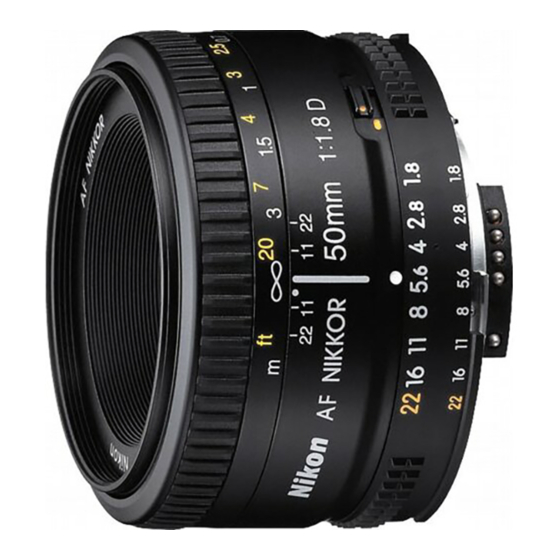Nikon AF Nikkor 50mm f/1.8D Instruction Manual - Page 3
Browse online or download pdf Instruction Manual for Camera Accessories Nikon AF Nikkor 50mm f/1.8D. Nikon AF Nikkor 50mm f/1.8D 15 pages. D-type af nikkor lens having built-in cpu and nikon bayonet mount
Also for Nikon AF Nikkor 50mm f/1.8D: Brochure & Specs (18 pages), Instruction Manual (2 pages), Instruction Manual (2 pages), User Manual (2 pages)

E n g l i s h - - - - - - - - - - - - - - - - - -
You are now the proud owner of the AF Nikkor 50mm f/1.8D, a lens that will
provide you with years of exciting picture-taking opportunities. Before using this
lens, please read these instructions and the notes on safety operations in your
camera's instruction manual. Also, keep this manual handy for future reference.
Major features
• Autofocus operation is possible with Nikon autofocus cameras (except the F3AF); manual focus
possible with all Nikon SLRs.
• Compact and lightweight. Ideal for ahigh-speed normal lens with amaximum aperture of f/1.8.
• For more accurate exposure control, subject distance information is transmilled from the lens to the
camera body, providing 3D Matrix Metering and 3D Multi-Sensor Balanced Fill-Flash with
appropriate Nikon cameras and Speedlights.
Important!
• Be careful not to soil or damage the CPU contacts.
• Do not attach the following accessories to the lens, as they might damage the lens CPU contacts
Auto Extension Ring PK-1, PK-11 (use PK-11 A), Auto Ring BR-4 (use BR-6 with BR-2A),
and K1 Ring.
Other accessories may not be suitable when this lens is used with certain camera bodies. For
details, refer to instruction manual for each product.
• This lens is not compatible when used with aNikon F3AF camera with the AF Finder DX-1
allached.
Depth of field
If your camera has adepth of field preview (stop-down) function, depth of field can be observed while
looking through the camera viewfinder.
Recommended focusing screens
Various interchangeable focusing screens are available for certain Nikon SLR cameras to suit any
type of lens or picture-taking situation. Those recommended for use with this lens are listed in the
table.
1\
Screen
C
EC-B
G3 H1
R
\
A
B
E
F G1 G2
H3 H2
J
K
L
M
P
S
U
Camera
0
EC·E
G4 H4
T
F6
© ©
©
©
©
F5+DP-30
© ©
© ©
©
©
©
F5+DA-30
© ©
© ©
©
©
©
(+1.0)
F4+DP-20
©
©
©
©
© ©
©
(+0.5)
F4+DA·20
©
©
©
© ©
©
(+05)
(+0.5)
(+1.0)
(+0.5) (+0.5)
(+0.5)
F3
© ©
©
©
© © © ©
© © ©
© :
Excellent focusing
o :
Acceptable focusing
Slight vignetting or moire patterns appear in the viewfinder, but not on the film.
L::;;.
:
Acceptable focusing
The in-focus image in the central spot may prove to be slightly out of focus on film. Focus on the
surrounding matte area.
( ) : Indicates degree of exposure compensation needed (Center-Weighted metering only). For F6 cameras,
compensate by selecting "Other screen" in Custom Setting "b6: Screen camp." and setting the EV level to -2.0
to +2.0 in 0.5 EV steps. When using screens other than type Bar E, "Other screen" must be selected even when
the required compensation value is "0" (no compensation lequired). For F5 cameras, compensate using
Custom Setting #18 on the camera body. For F4-Series cameras, compensate using the Exposure
Compensation Dial for the focusing screen.
See instruction manual of the camera body for more details.
Blank box means not applicable. Since type M screen can be used for both macrophotography at a1:1
magnification ratio and for photomicrography, it has different applications than other screens.
• When using the B/B2/B3, E/E2/E3, and K/K2/K3 focusing screens in cameras other than those listed above,
refer to the columns on the F4 + DP-20's B, Eand Kscreens, respectively.
